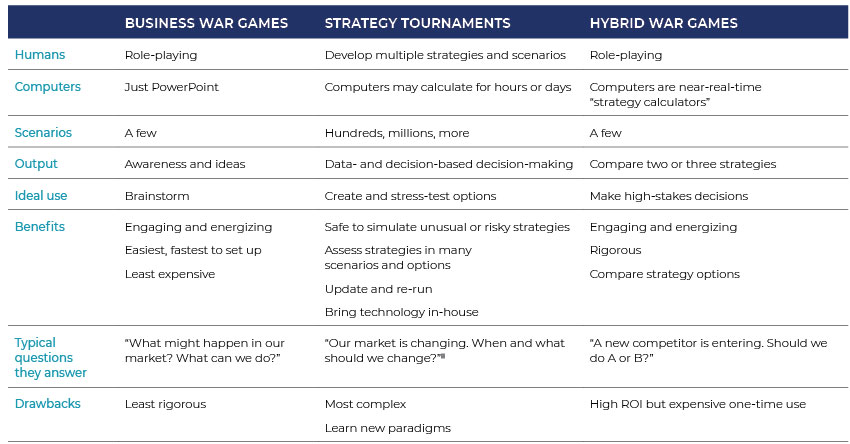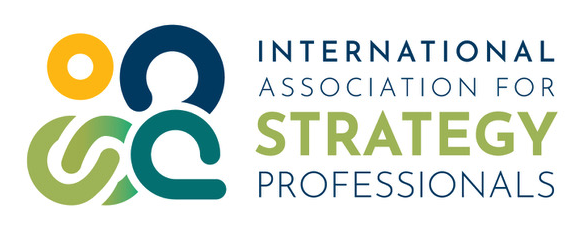By Mark Chussil
ABSTRACT
It’s a fuzzy, foggy world. Strategists want metaphorical telescopes to see their future. Alas, there is no such thing as the singular future. What strategists really need are wide-angle lenses to see many possible futures: options, alternatives, uncertainties, opportunities, and threats. That’s where strategy simulation comes in. This article breaks down strategy simulation and how to find ideal simulation outcomes for your company.
It’s a fuzzy, foggy world. Strategists want metaphorical telescopes to see their future. Alas, there is no such thing as the singular future. What strategists really need are wide-angle lenses to see many possible futures: options, alternatives, uncertainties, opportunities, and threats. That’s where strategy simulation comes in.
The why and what of strategy simulation
Competitive-strategy decisions always involve simulation. When you say this will work better than that, you have simulated the outcomes of two or more possible actions. You might not be conscious of the process – you might call it “experience” or “judgment” – but you have simulated, nonetheless.
Strategy simulation helps strategists answer two tough questions. Question one: Under these conditions, if I do this, and others do that, what will happen to my business? Question two: Which strategy should I choose?
Simulation answers these questions by helping strategists:
• Explore multiple futures to spot danger and opportunity.
• Avoid blind spots and cognitive bias.
• Set more realistic expectations than can be achieved with spreadsheets and forecasting.
• Experiment without risking real money and real careers.
• Stress-test actions in uncertain environments to see how uncertainty affects outcomes.
• Get inside competitors’ heads to see how they might respond.
• Build consensus, shared understanding, and a common language within the management team.
Because competitive-strategy decisions always involve simulation, the key question is not whether to simulate, but rather which simulation method will work best for the issues you want to tackle. We’ll discuss three approaches: business war games, computer-based simulation, and hybrid war games. Let’s start with what’s common among strategy simulations, then discuss differences.1
What’s common
Consciously or unconsciously, all types of strategy simulations:
• Answer “what’s the problem?” and “why hasn’t the problem already been solved?”
• Clarify the domain: customer segments, time horizon, geographic location, etc.
• Identify “players”: businesses, customers, regulators, suppliers, distributors, etc.
• Determine decisions teams may or must make, with “levers” they can pull: price, marketing spending, changes in capacity, loyalty programs, product enhancements, etc.
• Specify what’s in-bounds and what’s not.
• Set measures of success for the business teams and, optionally, how a team “wins.”
• Gather existing information and intelligence for a briefing book and, if used, the computer-based simulator.
• Stipulate rules of engagement for how teams interact.
• Populate the teams and brief them on their roles. Vitally important: Make it safe for teams role-playing competitors to compete hard with the company that employs them in real life – i.e., not career-threatening.
In addition, the following key elements are present and necessary in all strategy simulations. Each element can be satisfied, with different costs and benefits, by humans, computers, or human and computer teams.
• A way for the “home team,” its competitors, and relevant others to make decisions.
• A way for the consequences of those decisions to lead to outcomes.
• A way to analyze and gain insight from those outcomes.
What’s different
Business war games and computer-based strategy simulation can move bottom lines by hundreds of millions of dollars.
Business war games2 involve human teams that role-play your business, its key competitors, and relevant others such as customers, regulators, and distributors. Teams make decisions and interact with other teams. Judges ask questions and weigh in with feedback. War games typically take one or more days and simulate a few scenarios or strategy options. As few as fifteen people, and as many as a hundred or more, may participate. (My company ran one with 600 people.)
Note that you can learn even more in a business war game by challenging the war metaphor.3
Computer-based strategy simulation, including strategy tournaments,4 analyzes strategy options in many futures (perhaps billions), including multiple action-reaction strategies for each business team. Many people can contribute strategy options and they don’t have to convene in person to do so. Computer simulation can produce real surprises, help adjudicate differences of opinion, and be re-run when new information is available.
Hybrid war games combine business war games and computer-based simulation. Humans role-play the home team, competitors, and others. Their decisions go into a computer-based simulation model custom-configured for the problem at hand, which provides quantitative analysis.
The table below summarizes benefits and drawbacks of the three strategy-simulation methods.
How to maximize the benefits of your simulation
You maximize your benefits by using processes, tools, and attitudes that help you think strategically.
Come prepared to learn. That might sound obvious, or at least non-controversial. It’s not uncommon, though, for people to come prepared to prove that they and/or their strategy is right. That doesn’t make them wrong. They might not have participated in a simulation before; they might have a lot riding on the simulation outcome; they might see an opportunity to impress senior management; they might truly believe they’re right. Still, the value of simulation is to improve the quality of strategy decisions, and you maximize that value by listening and exploring. Or put it this way: If surprises come out of left field, watch left field.
If you and the simulation disagree, that doesn’t necessarily mean you’re wrong… and it also doesn’t necessarily mean you’re right.
Ensure safety and take advantage of that safety. The point of simulation is to help you discover potentially unexpected outcomes far enough in advance to take appropriate action. It’s critical not to censor participants or pre-ordain the answer.
Don’t introduce bias by stacking the deck. Build teams that are equally capable. Remind human judges (if used) to be impartial. Give simulated competitors as much latitude for action as you give your own simulated business. Provide the same information to all teams.
Use strategy variables to simulate strategy. You may simulate with computer models or mental models. Either way, focus on competitive-strategy variables (e.g., customer segments, switching costs, perceived quality, network effects, convergence of capabilities, Porter’s five forces, game theory) and competitors’ outcomes as well as the home team’s.
Simulate customers and competitors. Your simulation should
1) connect businesses’ simulated actions to customer perceptions, 2) allow businesses to act and react, and 3) ensure market shares always add up to 100%. Simulations that focus on financials or trends violate the first. Simulations that focus on a single company violate the second and third.
Surprise! Strategy simulation leads to both kinds of surprise, eureka! and argh! That’s a very good thing, because teams get surprised without losing real money or endangering real careers. In one hybrid war game simulation, highly experienced managers insisted they sold a commodity that couldn’t be differentiated… and then they discovered they could not possibly reach their goals without differentiating. Faced with that dilemma, they found a way to differentiate. It worked in the simulation, and it worked in real life.
Incidentally, part of the surprise is that solutions look obvious; in retrospect, that is. For many reasons, highly experienced, educated, incentivized, and very smart people simply do not see the solutions in advance.3
Don’t focus on pseudo-precision; the incremental difference between 3.23% growth and 3.18% growth. Action and reaction among competitors and relevant others outweigh decimal points. Think of it this way: Businesses cut their prices because their non-strategic analysis shows it’ll raise demand… if competitors don’t respond.
Simulations are fun and simulations are intense. They benefit from an executive sponsor who will get the resources you need. Simulations should include people from multiple functions (e.g., marketing, sales, R&D, finance, operations) for their expertise, perspectives, and buy-in. For role-playing simulations, put three to six people on teams. Why three to six? Fewer than three limits perspectives and debate; more than six reduces engagement. Big crowd? Consider parallel universes. Businesses are often surprised when parallel teams develop materially different strategies. That’s a good thing, because it stimulates creativity.
Professional tips
Work with the facilitator and the executive sponsor to define the problem, the market, relevant competitors, the time horizon, and the decisions to be made. Write down the answers; they belong in the briefing book.
During role-playing war games, teams will get excited and they’ll want to keep working on their strategy decisions. Be prepared to stick to reasonable limits based on a clear agenda. It’s important to note that strategy tournaments and online role-playing sims allow tremendous flexibility in how the simulation plays out. For example, they might involve a few online hours once a week for a month or so.
Most war games I’ve run have taken one to two and a half days. Highly detailed war games with big consulting firms can take considerably longer.
Run at least two “rounds” – that is, at least two simulations spanning the time horizon – because the second round is when the teams do their best, most-creative work… especially if they were alarmed by the first round.
And just for the record: Forecasting a profit and loss statement in Excel is not the same thing as simulating a strategy.
The bottom line
Strategy simulation can lead to consensus, decisions, and action. I’ve seen business units make 180° changes when they find unexpected dangers,6 develop creative solutions to pressing problems, and protect or add hundreds of millions of bottom-line dollars at a time. Simulation helps you see your business’ futures, and achieve the one you want.
References
- This is not a definitive list of strategy simulations – other firms have their own methods. For example, there is Benjamin Gilad, PhD, CEO of the Academy of Competitive Intelligence (www.academyci.com) and author of Business War Games (https://amzn.to/36j23ep); Red Team by Micah Zenko of the McChrystal Group (https://amzn.to/3u57gyM), PriSim Business War Games (educational simulations, www.prisim.com) and Monte Carlo simulation add-ins for Excel from Crystal Ball (https://bit.ly/3ifP7sk) and @Risk (www.palisade.com/risk). Major consulting firms have their approaches as well.
- Diamnod, D. (1996) Business is war – so let’s have a war game. Fast Company.
- Chussil, M. (2016) “Rally the troops” and other business metaphors you can do without. Harvard Business Review, November 24.
- Chussil, M. (2016) A tournament pits strategists against each other to see what works. Harvard Business Review , June 8.
- Chussil, M., (2021) When to switch strategy in a crisis. Harvard Business Review, February 3.
- Chussil, M., & Reibstein, D.J. (1997) Putting the lesson before the test: using simulation to analyze and develop competitive strategies. Wharton on dynamic competitive strategy. ch.17. John Wiley & Sons.
ABOUT THE AUTHOR
Mark Chussil is Founder of Advanced Competitive Strategies, Inc., and a 45-year veteran of competitive strategy. He’s worked with Fortune 500 companies around the world in industries from airlines to vaccines. Mark has written three books, twelve Harvard Business Review articles, and numerous other publications. He has an MBA from Harvard and a BA from Yale. Contact Mark for you and your group to enter the Top Pricer Tournament™.
For a bibliography of 50+ of Mark’s articles and posts about business war games, strategy simulation,
and related topics, visit
https://bit.ly/3KVjMYx.
E: This email address is being protected from spambots. You need JavaScript enabled to view it.








